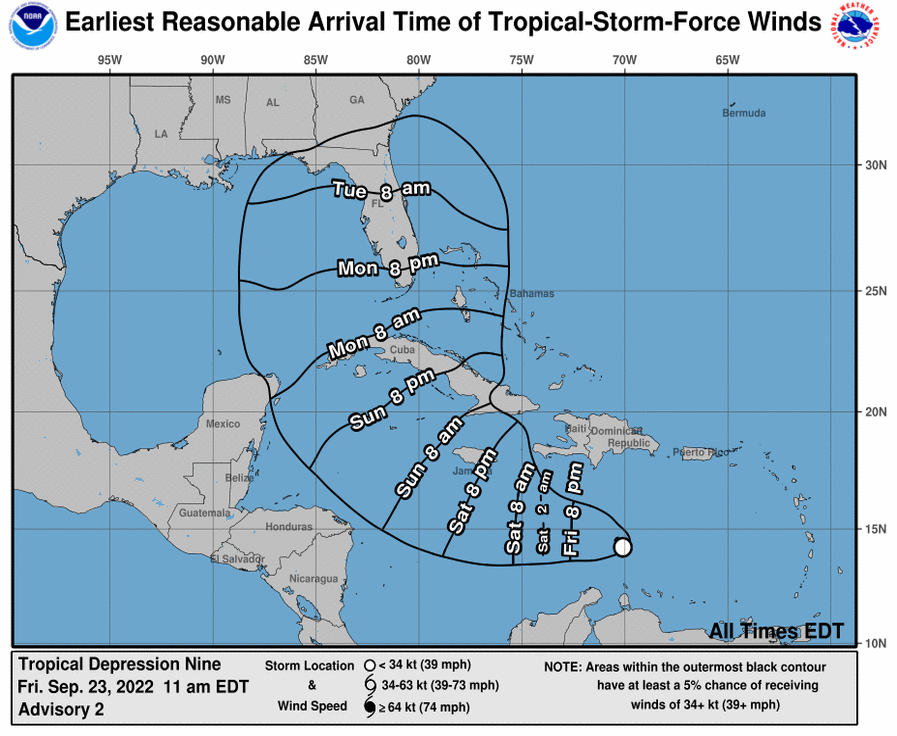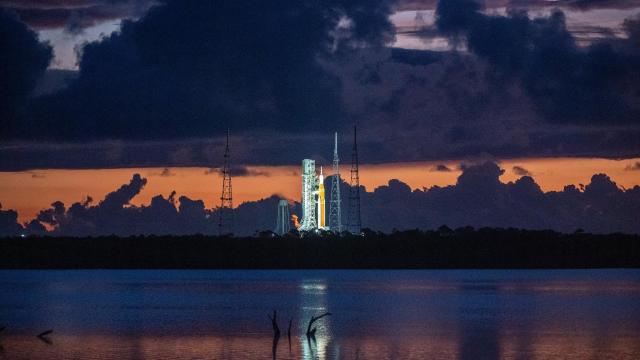We’ve got some good news and some bad news. Space Force has granted NASA’s request for an extension to launch the Space Launch System (SLS) rocket — yay — but a tropical storm is brewing in the Atlantic, which could threaten its scheduled launch on Tuesday, September 27.
NASA finally got the Space Force waiver it was seeking, as John Blevins, SLS chief engineer, told reporters earlier this afternoon. The space agency can now proceed with a launch on either September 27 or October 2. This will be NASA’s third attempt to launch the rocket and the Artemis 1 mission, in which an uncrewed Orion capsule will journey to the Moon and back.
But on the same day the nation’s space agency got this good news, the nation’s weather agency, NOAA, issued warnings about Tropical Depression Nine, which is currently brewing in the Gulf of Mexico and threatening the Florida peninsula. Tom Whitmeyer, deputy associate administrator for common exploration systems development at NASA, said they’ll make a decision about whether to postpone the launch and send the rocket back to the Vehicle Assembly Building (VAB) on Saturday morning or Saturday afternoon at the latest.

Following the second failed attempt to launch the Space Launch System earlier this month, NASA looked to September 27 as the next possible day to send the mega Moon rocket to space. But as NASA had exceeded its permitted time allowance, and not wanting to roll the 97.84 m-tall (98-metre) rocket back to the VAB, the space agency asked the Eastern Range for an extension. The Range, a branch of the U.S. Space Force, oversees launches from Kennedy Space Centre and Cape Canaveral, and NASA cannot fly without its permission.
The Eastern Range’s concern had to do with the rocket’s flight termination system batteries, which need to be tested and recharged at regular intervals. This can’t be done at the launch pad. The abort system is designed to destroy the rocket mid-flight should it suddenly veer off course and threaten populated areas. Space Force analysed the information provided to it by NASA and concluded that the rocket is safe for launch, Blevins explained.
During today’s press briefing, reporters repeatedly asked NASA officials about the looming storm, as they seemed surprisingly nonchalant about the whole thing. Said Whitmeyer: “It is not even a named storm — it’s a tropical depression.” It was a curious remark to make, with the vulnerable SLS currently standing on Launch Pad 39B and as projections show winds from the “unnamed storm” potentially reaching Kennedy Space Centre on Monday evening or early Tuesday morning. NASA, should it choose to move SLS back to the VAB, will have to get moving, as the process takes about two days.
NASA on the forecast pic.twitter.com/5zxBHAVJT7
— Loren Grush (@lorengrush) September 23, 2022
The officials said SLS can withstand 137 km-per-hour wind gusts at the pad, while rollback can withstand sustained winds reaching 74 km/h. A meeting will be held tonight at 5:00 p.m. ET to review the current situation.
It’s a real shame that Tropical Storm Nine had to appear right now. A cryogenic tanking test held earlier this week went well, with NASA achieving all main objectives. The test was done to confirm a repaired hydrogen leak, in which two seals were replaced at the quick disconnect fitting between the liquid hydrogen fuel line and the core stage. The hydrogen leak happened during the second failed attempt to launch the rocket, on September 3. The first test, on August 29, was scrubbed due to erroneous engine temperature readings.
SLS is a key component of NASA’s Artemis program, which seeks a sustained return to the Moon. The $US50 ($69) billion rocket has been beset with delays and budget overruns and is currently being haunted by hydrogen leaks. The looming storm could potentially push back the inaugural launch even further, with the next launch phase running from October 17 to 31.
